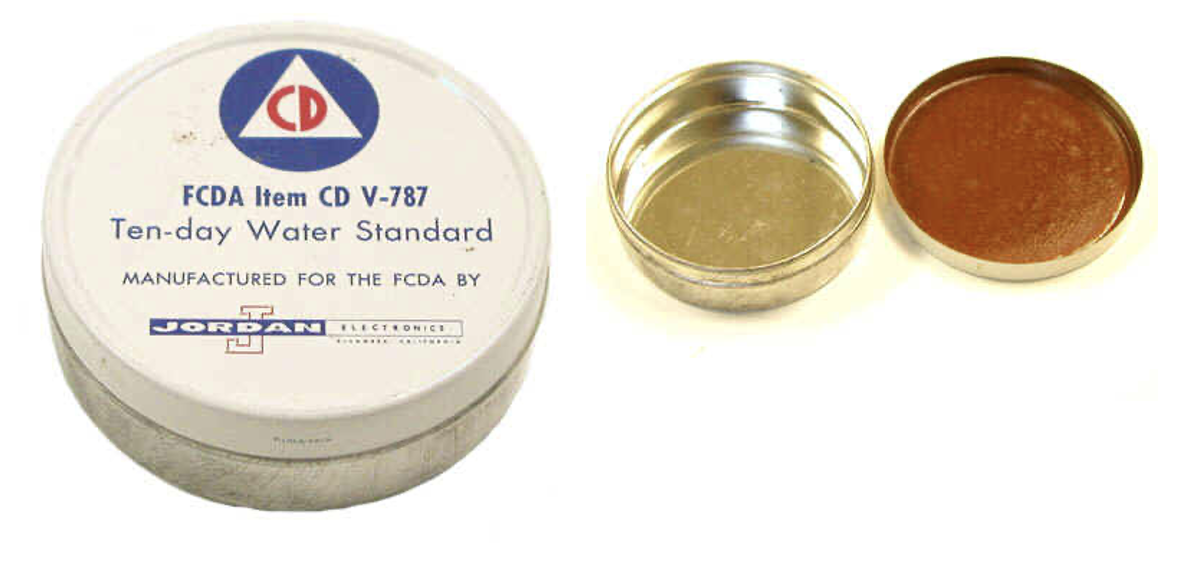CD V-787 Ten Day Water Standard (ca. 1957-1958)
This CD V-787 Ten-day Water Standard was manufactured, probably in 1957 or 1958, by Jordan Electronics. The container states that it was manufactured for the FCDA, and the latter was replaced by the Office of Civil and Defense Mobilization (OCDM) in 1958.
Its purpose was to help make a somewhat quantitative evaluation of fallout in food and water using the CD V-700 GM detector. The Item Specifications note that “The comparison standard is designed for use under conditions of extreme emergency.”

Size: 3” diameter x 1” high
Container: Metal can
Quoting the 1957 Civil Defense Technical Bulletin TB-11-9. Emergency Measurements of Radioactivity in Food and Water.
"(b) Place the standard face up on a level surface [the standard is deposited on the inside of the container lid rather than the bottom. Refer to photo above right]. Turn the Geiger counter selector switch to the least sensitive scale and place the probe, with the beta shield open, across the standard with the exposed part of the Geiger tube facing the standard. The probe should rest on the edge of the standard container, or a jig should be used so that the exact position of the probe may be reproduced. The instrument reading should be noted."
"(c) Fill or pack the suspected food or water to a depth of at least 2 mm in a container the same size as the standard. A greater depth may be used, if necessary, to permit positioning the probe the same distance from the sample's surface as it was from the standard's surface. If standard 4 ounce ointment tins are used, the container should be filled to the indentation circling the tin. Place the probe, again with the beta shield open, in exactly the same position with respect to the surface of the sample as it was with respect to the standard. If the reading is less than that of the standard, the food or water may be used for the period indicated [i.e., ten days]."
Although the instructions do not say this, the empty bottom of the standard container could be used to hold the food or water being tested. In this case, the container would be filled up to the circular indentation.
I believe that this method for evaluating water supplies was first described in an article by Hursh et al. in the November 1951 issue of Nucleonics. Explaining the purpose of their work, the authors stated: "An early evaluation of the degree of contamination in a community's water supply following an atomic bomb explosion is essential not only to prevent ingestion of dangerous amounts of fission products but also to avoid the equally serious mistake of denying a stricken community access to drinking water which in fact could be used with safety. The purpose of the work described here was to determine whether survey instruments in common use for beta and gamma area monitoring could be adapted for emergency water monitoring during a period of 30 days following an explosion."
According to the 1962 Department of Defense item specification, the standard was manufactured by mixing 3.0 grams of uranyl acetate with 5 grams of epoxy resin in a “standard 4 ounce circular seamless ointment tin.” An earlier description of this type of standard is found in the 1952 (reprinted 1957) Technical Bulletin Emergency Measurements of Radioactivity in Food and Water. Based on the latter’s instructions however, it would seem that civil defense personnel were originally expected to produce their own standards.
The 1962 annual report of the Office of Civil Defense indicates that Trionics, Incorporated had completed "development of [a] 10-day Water Radiation Standard," and that 561,475 of these CD V-787 Food and Water standards had been ordered. This was in addition to the previous 60,000 that had been ordered through FY 1958 (the ones produced by Jordan). Nevertheless, the 1963 Handbook for Radiological Monitors makes no mention of this standard when it describes the appropriate methodology for monitoring food and water. I was told by Marlow Stangler that these standards were perceived as being nearly useless and that given the circumstances following a nuclear explosion, people were probably just as well off assuming that the water was safe to drink if there was no detectable grit in it from fallout. A table in Radiological Instruments: An Essential Resource for National Preparedness (CPG 3-1), published in 1986, indicates that all of the approximately 60,000 CD V-787 standards procured by the government had been excessed or disposed of. This suggests that the OCD order for 561,475 of the standards developed by Trionics, Inc., was canceled or never filled.
Ten of these CD V-787 standards were provided with each CD V-457 demonstration set, and two were included in each of the CD V-755 High School demonstration kits.
Donated by the Ohio Bureau of Radiation Protection.
References
- Civil Defense Technical Bulletin Emergency Measurements of Radioactivity in Food and Water, TB-11-9, December 1952 (reprinted July 1957).
- Department of Defense, Office of Civil Defense, Standard Item Specification: Item No. CD V-787, Revised April 1, 1962.
- Hursh, J. B., Zizzo, S. and Dahl, A.H. Survey Meters for Water Monitoring Nucleonics November 1951, p. C-16 - C-20.
